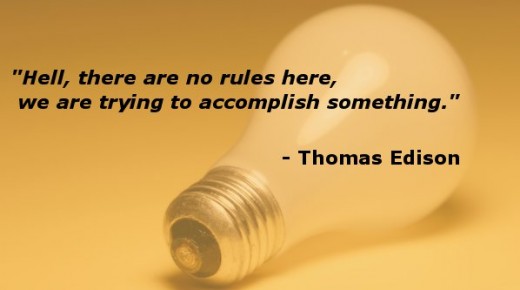Coming Up With Ideas - 10 Tips & Tricks

At some point we all find ourselves searching for an idea. Whether you're a writer trying to break through a bad case of writer's block, or you just want an idea for a new dessert tonight, here are 10 tips and tricks that can help.
There Are No Rules Here
First the rules: When asked by a new employee what the rules were for working in his laboratory, Thomas Edison said, "Hell, there are no rules here, we are trying to accomplish something".
That is the only hard-and-fast rule about creativity: There are NO rules. It doesn't matter how things have always been done, or how you think they should be done. You don't have to continue doing them that way.
In fact, there are few things that stimulate creativity more than INTENTIONALLY BREAKING THE RULES (the "rules" being however you believe things must be done). If you usually keep your ideas on index cards, write them in crayon on colored construction paper. If you usually change out of your pajamas and get dressed for the day before working at your computer, sit down at the computer naked instead. Keep your brain guessing!

Tips and Tricks For Getting Ideas
Now that you know the rules, here are some tips and tricks that can help you be more creative:
01. See the world differently. At any given moment, we only perceive a small amount of what is around us. What you need may be right beside you, if only you could see it. Go past first impressions, and make a conscious effort to really observe what is around you. Look for the unnoticed and unusual in the commonplace.


02. Don't be afraid to "borrow". Use an existing idea (even someone else's) as a starting point. It's not unethical. Writers, composers and other creative folk do it all the time - especially when called on to create "on demand". It's simply to get the process started. Take an idea and turn it upside-down and backwards. Make it bigger or smaller. Break it up and recombine the parts the wrong way, or combine them with elements of something else. Eventually this will trigger the spark of an original idea, and you're off and running.
03. Combine unrelated things or ideas. Force things together that have nothing to do with each other, and see what happens. Are there connections or similarities that you hadn't seen before? If you're lucky, something entirely new and wonderful will come from the fusion. In the 1950s, white Country and Western musicians took the revolutionary step of playing what was, at the time, considered "black" or "race" music (blues and R&B). The result? Rock and Roll!


04. Ask some simple questions. Why? is an especially good question. Why does something work the way it does? Maybe there was a good reason for it at one time, but things change. That reason may no longer be valid.
What if? questions are also great - the more outrageous, the better! What if an elephant could fly? Walt Disney made a pretty good movie from that one. Sometimes there's no way of even knowing what is and isn't outrageous until after the fact: What if the world isn't flat? What if it's really round?
05. Think on paper. Thinking is hard! Give your brain a little help - get a pad of paper and brainstorm, create mind maps, freewrite, or even just doodle aimlessly. These activities enhance the thinking process and stimulate your brain to go where it might not otherwise. Especially if you do most of your work on a computer, try using some real paper and a pencil instead (break the rules, remember?).
06. Ignore the inner voices. Don't be restricted by logic ("that doesn't make sense"), what other people might think ("they'll laugh at me if I do that"), or anything else the voices in your head say to dissuade you (and they will try). Your ideas will need a "reality check", but not while they are being formed. Your mind can create ideas, and it can evaluate ideas, but not at the same time. Create first, evaluate later.


07. Forget what you know. The more you know about something, the harder it can be to come up with new insights about it. Your thinking naturally tends to stay within the realm of what you "know" is possible. But history is full of people who, unaware that something "couldn't be done", actually tried to do it - and succeeded!


08. Solve the right problem. Early in the space program, NASA realized that ink in a pen would not flow properly without gravity, and invested a lot of time and money to create a "space pen". The Russians simply used a pencil.
NASA had asked the wrong question ("How can we get a pen to write in space?"), while Russia had asked the right one ("How can our cosmonauts write in space?"). Do you really understand what it is you're trying to accomplish?
09. Don't despair. Sometimes, despite your best efforts, ideas simply won't come. Rather than bear down and work even harder, ultimately driving yourself into a frenzy, just let it go for a while. Take a break. Go for a walk, or even take a nap. Your subconscious mind will continue working, and will deliver exactly what you need - usually during a "mindless" activity such as showering or shaving, or first thing upon awakening.
10. Don't stop looking after the first idea. The noted scientist Linus Pauling once said, "The best way to have a good idea is to have a lot of ideas". You're more likely to find that great idea you need from a list of 50 than you are from a list of only two or three. Even if you get an idea you're sure will work, keep looking for a while longer. There may be an even better one out there, just waiting for you to put it together.

These 10 tips and tricks can help you come up with the ideas you need, and improve the quality of the ideas you get, but only if you actually sit down (or stand on your head) and DO them. As one of history's greatest creative minds has said:

Light bulb clip art from http://www.artclips.com.

More Creative Thinking Secrets:










